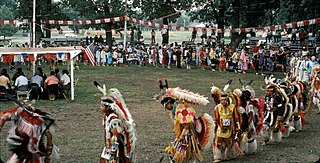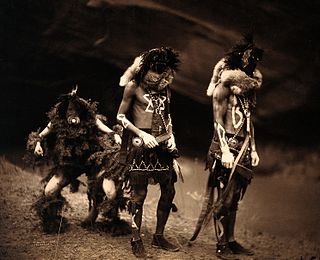Crow religion is the indigenous religion of the Crow people, Native Americans of the Great Plains area of the United States.
The Blackfeet are a tribe of Native Americans who currently live in Montana and Alberta. They lived northwest of the Great Lakes and came to participate in Plains Indian culture.

A pow wow is a sacred social gathering held by many North American indigenous communities. A modern pow wow is a specific type of event for Native American people to meet and dance, sing, socialize, and honor their cultures. Pow wows may be private or public. There is generally a dancing competition, with many types of traditional dances, often with significant prize money awarded. Pow wows vary in length from a one-day event, to major pow wows called for a special occasion which can be up to one week long.
Peyote songs are a form of Native American music, now most often performed as part of the Native American Church. They are typically accompanied by a rattle and water drum, and are used in a ceremonial aspect during the sacramental taking of peyote.

Indigenous music of North America, which includes American Indian music or Native American music, is the music that is used, created or performed by Indigenous peoples of North America, including Native Americans in the United States and Aboriginal peoples in Canada, Indigenous peoples of Mexico, and other North American countries—especially traditional tribal music, such as Pueblo music and Inuit music. In addition to the traditional music of the Native American groups, there now exist pan-Indianism and intertribal genres as well as distinct Native American subgenres of popular music including: rock, blues, hip hop, classical, film music, and reggae, as well as unique popular styles like chicken scratch and New Mexico music.
When speaking of the music of Syria, it is important to remember that there are certain musical traditions and practices that have been present in Syria longer than others. There have been musical influences introduced into Syria through multiple eras of conquest and influences from surrounding cultures in modern-day Syria. Lying near Egypt, Israel and connected to southern Europe by the Mediterranean, Syria became host to many distinct cultural musics through trade and route. The music present in Syria is related greatly to poetry, influenced greatly by the Bedouin nomadic tribes, the maqam system in Arabic classical music, as well as influenced greatly by the geopolitical movement and conflict in the Middle East. Syrian music generally has a singer that is accompanied by three or four instruments. The texture is usually thin but can become more dense depending on the use of each instrument. Music is tightly linked to poetry in Syria. The classical music of Syria is part of the greater Arabic music world. The main components are a maqam and an iqa (rhythm/metre). A maqam is a set of scales made of up of three or four notes. A maqam will have two or three of these scales put together which is then played over the iqa (rhythm). Both the maqam and iqa can be advanced or simple to play. Both the maqam and iqa are to be thought of as a structure that the musicians would then ornament with the playing. Syria and the Middle East have a long history of conquest and conflict that have lead to a diaspora and modern diaspora has lead to refugee camps. Music has become a means of consolation and preservation of culture in the refugee camps.
Indigenous music of Canada encompasses a wide variety of musical genres created by Aboriginal Canadians. Before European settlers came to what is now Canada, the region was occupied by many First Nations, including the West Coast Salish and Haida, the centrally located Iroquois, Blackfoot and Huron, the Dene to the North, and the Innu and Mi'kmaq in the East and the Cree in the North. Each of the indigenous communities had their own unique musical traditions. Chanting – singing is widely popular and most use a variety of musical instruments.
Blackfoot music is the music of the Blackfoot people. Singing predominates and was accompanied only by percussion.
Pueblo music includes the music of the Hopi, Zuni, Taos Pueblo, San Ildefonso, Santo Domingo, and many other Puebloan peoples, and according to Bruno Nettl features one of the most complex Native American musical styles on the continent. Characteristics include common use of hexatonic and heptatonic scales, variety of form, melodic contour, and percussive accompaniment, melodic range averaging between an octave and a twelfth, with rhythmic complexity equal to the Plains Indians musical sub-area.
Navajo music is music made by Navajos, mostly hailing from the Four Corners region of the Southwestern United States and the territory of the Navajo Nation. While it traditionally takes the shape of ceremonial chants and echoes themes found in Diné Bahaneʼ, contemporary Navajo music includes a wide range of genres, ranging from country music to rock and rap, performed in both English and Navajo.
Yuman music is the music of Yumans, a group of Native American tribes from what is now Southern California and Baja California. They include Paipai, Havasupai, Yavapai, Walapai, Mohave, Quechan, Maricopa, Tipai-Ipai, Cocopa, and Kiliwa people. Folk songs in Yuma culture are said to be given to a person while dreaming. Many individuals who are in emotional distress go to a secluded area for a few weeks, there to receive new songs.
Kiowa music is the music of the Kiowa Tribe of Oklahoma. The Kiowa are a federally recognized tribe, meaning they have a functioning government-to-government relationship with the United States government.

The American Indian Religious Freedom Act, Public Law No. 95–341, 92 Stat. 469, codified at 42 U.S.C. § 1996, is a United States federal law, enacted by joint resolution of the Congress in 1978. Prior to the act, many aspects of Native American religions and sacred ceremonies had been prohibited by law.

Native American religions are the spiritual practices of the indigenous peoples of North America. Ceremonial ways can vary widely and are based on the differing histories and beliefs of individual nations, tribes and bands. Early European explorers describe individual Native American tribes and even small bands as each having their own religious practices. Theology may be monotheistic, polytheistic, henotheistic, animistic, shamanistic, pantheistic or any combination thereof, among others. Traditional beliefs are usually passed down in the forms of oral histories, stories, allegories, and principles.

The Native American Church (NAC), also known as Peyotism and Peyote Religion, is a Native American religion that teaches a combination of traditional Native American beliefs and Christianity, with sacramental use of the entheogen peyote. The religion originated in the Oklahoma Territory (1890–1907) in the late nineteenth century, after peyote was introduced to the southern Great Plains from Mexico. Today it is the most widespread indigenous religion among Native Americans in the United States, Canada, and Mexico, with an estimated 250,000 adherents as of the late twentieth century.

The peyote is a small, spineless cactus which contains psychoactive alkaloids, particularly mescaline. Peyote is a Spanish word derived from the Nahuatl peyōtl, meaning "caterpillar cocoon", from a root peyōni, "to glisten". Peyote is native to Mexico and southwestern Texas. It is found primarily in the Sierra Madre Occidental, the Chihuahuan Desert and in the states of Nayarit, Coahuila, Nuevo León, Tamaulipas, and San Luis Potosí among scrub. It flowers from March to May, and sometimes as late as September. The flowers are pink, with thigmotactic anthers.

Plains hide painting is a traditional Plains Indian artistic practice of painting on either tanned or raw animal hides. Tipis, tipi liners, shields, parfleches, robes, clothing, drums, and winter counts could all be painted.
A tetratonic scale is a musical scale or mode with four notes per octave. This is in contrast to a heptatonic (seven-note) scale such as the major scale and minor scale, or a dodecatonic scale, both common in modern Western music. Tetratonic scales are not common in modern art music, and are generally associated with prehistoric music.
A ditonic scale is a musical scale or mode with two notes per octave. This is in contrast to a heptatonic (seven-note) scale such as the major scale and minor scale, or a dodecatonic scale, both common in modern Western music. Ethnomusicologist Bruno Nettl noted that ditonic scales were common in many parts of the world but often limited to specific music types, such as children's songs, with the exception of some tribal societies.

Big moon peyotism was introduced as a variant of the Peyote religion in the 1880s that incorporated Christian, Caddo, and Delaware religious symbols with the consumption of peyote intertwined from Caddo and Delaware rituals. The plant itself, peyote, had been used for spiritual practice by the Mescalero Apache in the 1880, and their use of it influenced other tribes like the Comanche and Kiowa. Peyotism inquires all of the same traits found in other religions such as a doctrine, a ritual, and ethics. The doctrine includes the belief of the actuality of power, incarnation, and spirits. It soon spread all over the Indian Territory while its native people were searching for spiritual help. Peyotism at this point, was a spiritual path that was soon to be taken in Indian Territory. Around 1890, the Caddo, Delaware and Quapaw tribes became the first practitioners of peyote. Black Wolf, a practitioner from the Caddo tribe, brought the religion of little moon peyotism to the Osage people. Black Wolf had intrigued enough of the tribe that his peyote prayers and rituals had truth and value, so the people sent him to heal a sick person in their tribe. His prayers and rituals could not save their life, so peyotism was not being spread for a while. After the native people's dry spell towards peyotism, it returned to the Osage tribe around 1898








